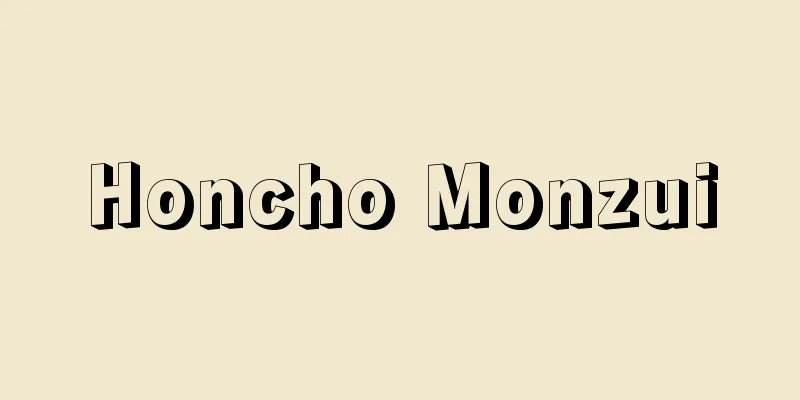Honcho Monzui

|
A collection of Chinese poetry and prose from the Heian period. 14 volumes. Compiled by Fujiwara no Akihira. It was probably compiled around the Kohei era (1058-65). Following the example of Yao Hyun of the Song dynasty's Tobunsui, this collection selected excellent poetry and prose from the Heian period to serve as a model for future generations and to aid in the literary education of children. It contains 427 works by 69 people over a period of 17 generations and over 200 years, from Emperor Saga to Emperor Goichijo. The authors ranged from emperors to provincial governors, but the core of the collection was made up of scholar-poets from the Sugawara and Oe families, and the editor probably wanted to look back with joy on the heyday of Chinese poetry and prose during the Engi (901-923), Tenryaku (947-957), and Kanko (1004-12) eras. The sources were likely to be anthologies such as the Fusoshu, family anthologies such as the Kanke Bunso, and official documents. The classification format follows that of the Monzen, but the content is appropriate to the social circumstances of the time, and although the arrangement of the works suggests a compilation intention, there is no complete arrangement standard. The works are in the four-six benrei style, with elegant expressions and intricate couplets, and are worthy of the name of the quintessence of prose. Moreover, because it includes all kinds of writing that was done at that time, we can learn about the style of writing at that time. Many of the works are empty in content despite the elegance of their expressions, but there are masterpieces such as Prince Kaneakira's "Tokyufu" and Yoshishige Yasutane's "Chiteiki," and the editor's originality can be seen in prose such as "Hakuchoo" and "Dojo Hoshi Den," and in vulgar comedy such as "Dan Dan Konin Fu" and "Tetsui Den." The influence of this book on later literature was widespread, and its classification and compilation became the standard for later collections of writing, its writings were cited and used as models in writing guidebooks, and its excellent poems were praised by people through recitation and chanting, and it contributed greatly to the completion of Japanese-Chinese mixed writing by being drawn into medieval war tales and Noh songs. [Shosuke Ozone] "Kakimura Shigematsu's 'Honcho Bunsui Annotation', 2 volumes (1968, Tomiyamabo)" Source: Shogakukan Encyclopedia Nipponica About Encyclopedia Nipponica Information | Legend |
|
平安時代の漢詩文集。14巻。藤原明衡撰(あきひらせん)。康平(こうへい)年間(1058~65)ごろ成立か。宋(そう)の姚鉉(ようげん)の『唐文粋(とうぶんすい)』に倣い、平安時代の詩文の優れたものを選んで後世の作文の手本にし、子弟の文学教育に役だてる目的で編纂(へんさん)した。嵯峨(さが)天皇から後一条(ごいちじょう)天皇まで17代200余年間における69人の作品427編を収める。作者は天皇から国司に及ぶが、菅原(すがわら)・大江の両家を頂点とする学者詩人が中核を占めており、編者は延喜(えんぎ)(901~923)、天暦(てんりゃく)(947~957)、寛弘(かんこう)(1004~12)の漢詩文隆盛時代を謳歌(おうか)回顧したかったのであろう。その資料となったのは『扶桑集(ふそうしゅう)』などの撰集、『菅家文草(かんけぶんそう)』などの家集および公文書と思われる。分類の体裁は『文選(もんぜん)』に倣っているが、当時の社会事情に適した内容を有しており、作品の配列には編纂意図がうかがわれるが、完全な配列基準をもっていない。その作品は華麗な表現と巧緻(こうち)な対句をもつ四六駢儷(べんれい)文で、文章の精粋の名に恥じない。しかも当時行われたあらゆる文章の種類を含んでいるので、当時の文章の形式を知ることもできる。表現の華麗に反して内容の空虚なものが多いが、兼明(かねあきら)親王の「莵裘賦(ときゅうふ)」や慶滋保胤(よししげのやすたね)の「池亭記(ちていき)」のような傑作もあり、また「白箸翁(はくちょおう)」「道場法師伝」のような散文や「男女婚姻賦」「鉄槌(てっつい)伝」のような猥雑(わいざつ)な戯文に編者の独創性がうかがえる。本書の後代文学に及ぼした影響は広範で、その分類編纂が後の文集の規範になり、その文章は作文指南書に引用されて手本になり、その秀句は朗詠や唱導を通して人々に賞翫(しょうがん)され、中世の軍記物語や謡曲に引かれて和漢混交文の完成に大きな貢献をした。 [大曽根章介] 『柿村重松著『本朝文粋註釈』全2巻(1968・冨山房)』 出典 小学館 日本大百科全書(ニッポニカ)日本大百科全書(ニッポニカ)について 情報 | 凡例 |
>>: Untitled poem from Japan - Honcho Mudaisi
Recommend
high hat
…A hat with a high crown and flat top worn by men...
Kabayama ruins
This site from the Early to Late Jomon period is l...
Carpați (English spelling)
…The mountain range that forms part of the Alpine...
Uji Issaikyoe - Uji Issaikyoe
…In Japan, the first copy of the entire Buddhist ...
Hill, George Roy
Born: December 20, 1921, Minneapolis, Minnesota [D...
YS-11 - YS-11 (English spelling)
A medium-sized twin-engine turboprop transport air...
ENGLISH
(From Inglês, Inglez Engelsch) An old name for Eng...
Sacramento (English spelling) Sacramentum; sacrament
Sacrament. A sign of an inward or spiritual grace ...
Human relations
A general term for theories that discovered that ...
Aubrey, C.
...The Japanese name is Murasakinazuna. The genus...
Kurt Koffka
German psychologist and one of the leading figure...
Hao Yi-xing (English spelling)
[Born] Qianlong 22 (1757) [Died] Daoguang 5 (1825)...
Ahmadnagar Kingdom - Ahmadnagar Kingdom (English spelling)
A Muslim kingdom (1489-1636) in western India. It ...
Prince Takehito
Year of death: July 5, 1913 Year of birth: Bunkyu ...
Plasma rocket
...However, the thrust density is low, so colloid...









